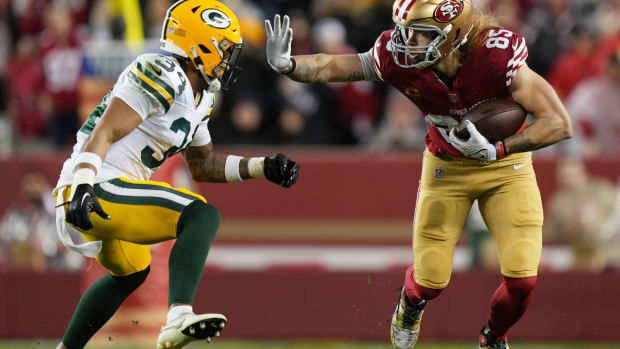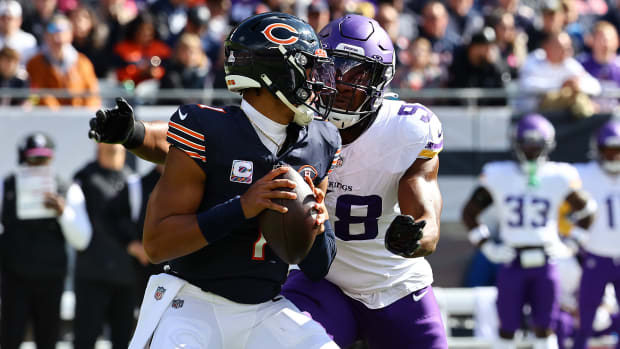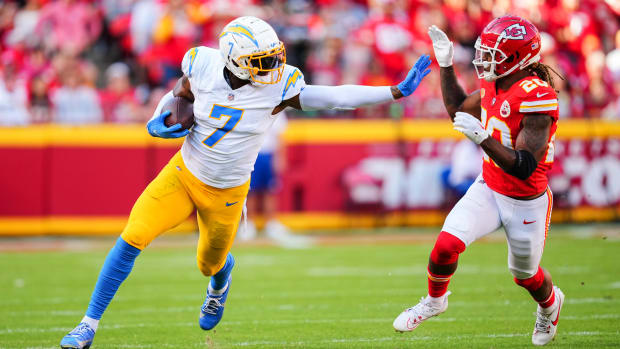Three Ways Mitchell Trubisky Already Trails in QB Battle with Nick Foles
When the Nick Foles and Mitchell Trubisky quarterback battle come down, Trubisky could have very little weighing in on his side to make victory possible in a fair contest.
Taken at their word, Bears coach Matt Nagy and GM Ryan Pace do insist this will be a fair contest.
Trubisky's advantages in this battle are mobility and familiarity with the offense Matt Nagy uses.
With the coronavirus delay possibly impacting the May 25 start of organized team activities, Foles will be limited in how much he can work into a new offensive system.
It's true he had exposure to this offense in Kansas City and Philadelphia, but the terminology is different and the ways it takes root and expands once they've applied it can make the offense seem much different.
So Trubisky will have this edge. Foles will, as they say, have a lot of catching up to do.
The mobility factor can't be denied, although last year Trubisky limited this himself by refusing to scramble as much as he had in the past. He said at the conclusion of preseason he needed to become more of a passer who is looking to strike downfield through the air than by scrambling, and this obviously had something to do with the fact he ran for only 193 yards after gaining 421 in 2018. They were all big yards.
Also, the edge this provides can be minimal. Foles has a height advantage and can see downfield over the defense better. So he can hold onto the ball longer and wait for the last second until a receiver comes open. Trubisky sometimes holds the ball and then scrambles into a sack that makes his offensive line look bad.
Still, those are two overall assets Trubisky has. They can't offset these three strengths any quarterback would love to have over a competitor for a starting job.
Passing Accuracy
Trubisky's career accuracy is 63.4% completions, which is beyond adequate and even better than Foles' 61.9%. Yet Foles' career changed when he got into this offense again in Kansas City and since then he has completed a dead-on 66.5%
Percentages do not tell the full tale on accuracy. You can watch with the naked eye and see this. Trubisky passes often come behind, higher or lower than needed for the receiver to make a clean grab. When Foles gets into his rhythm and knows the offense, his passes go exactly where needed for receptions.
Pro Football Focus has long condemned Trubisky's inaccuracy as a deep passer. That's not even as much of a problem in this offense as his inaccuracy as a short passer.
There's even less room for error in accuracy in the red zone and it's little wonder the Bears ranked only 24th in red zone scoring last year with Trubisky as their starting quarterback.
A scathing indictment of Trubisky's inability to complete shorter passes on the mark in the red zone are Allen Robinson's touchdown totals in the red zone. He had only two TD receptions in the red zone from Trubisky in 2018. He upped it to four in 2019, but in 2019 he had none from Trubisky until Week 7 and by then the Bears' season was well on its way to 8-8 with a 3-4 record.
It's Robinson's strength to go up and get a ball in a crowd. He knows how to shade defenders off of the throw with his body better than anyone on the team, if not the entire NFC North. And he didn't have a red zone TD catch from Trubisky until Week 7 last year. The ball just needs to be in the right spot to go after it.
It's rare when Trubisky gets a fade route or back-shoulder throw in the end zone to exactly the spot where Robinson or any other receiver can go up for it and fend off a defender for the ball.
Foles, on the other hand, made a living out of hitting tight ends on seam routes or wide receivers in stride on the skinny post. He threw the back-shoulder to Alshon Jeffery well. These were all key throws in the Super Bowl run with Philadelphia.
Decisiveness
Last year Matt Nagy kept talking about Trubisky's comfort in the 200-level offense and even said in May at organized team activities his quarterback had taken the big step.
"Without a doubt I can say with pure conviction we're at 202 right now," Nagy said.
Even in September, October, November or December Trubisky never seemed comfortable enough in the offense and at reading defenses to make consistently quick decisions and deliver the ball on time.
It's part of the reason they've been near the bottom of the league for two years in yards after the catch by receivers. They don't get the ball in time to run after the catch.
Foles specializes in making the quick decision and getting the ball out.
The RPO style of offense the Bears run often gets mistaken for needing a passer who can run the ball because there is a read-option run aspect to it by the passer. However, the RPO first requires the quick and accurate decision by a passer to put the ball in the running back's belly or to pull it back and throw it. Foles does this well while Trubisky struggles to get it done.
Calm Hand
Trubisky rallied the Bears against the Denver Broncos with a miracle fourth-down conversion to Allen Robinson to set up a winning field goal, and has authored four comebacks and six game-winning drives in his three seasons and 41 games. Foles has eight comebacks and 10 game-winning drives in 58 games, so his ability under pressure is without question.
Foles led a comeback in the biggest game of all to win a Lombardi Trophy so Trubisky's steadiness as the field leader doesn't compare.
"This is a kid who's been through a lot of different situations," Nagy said. "He's been a Super Bowl MVP. He's been in pressure moments and he understands a lot of the things that we're looking for."
Twitter: BearDigest@BearsOnMaven




